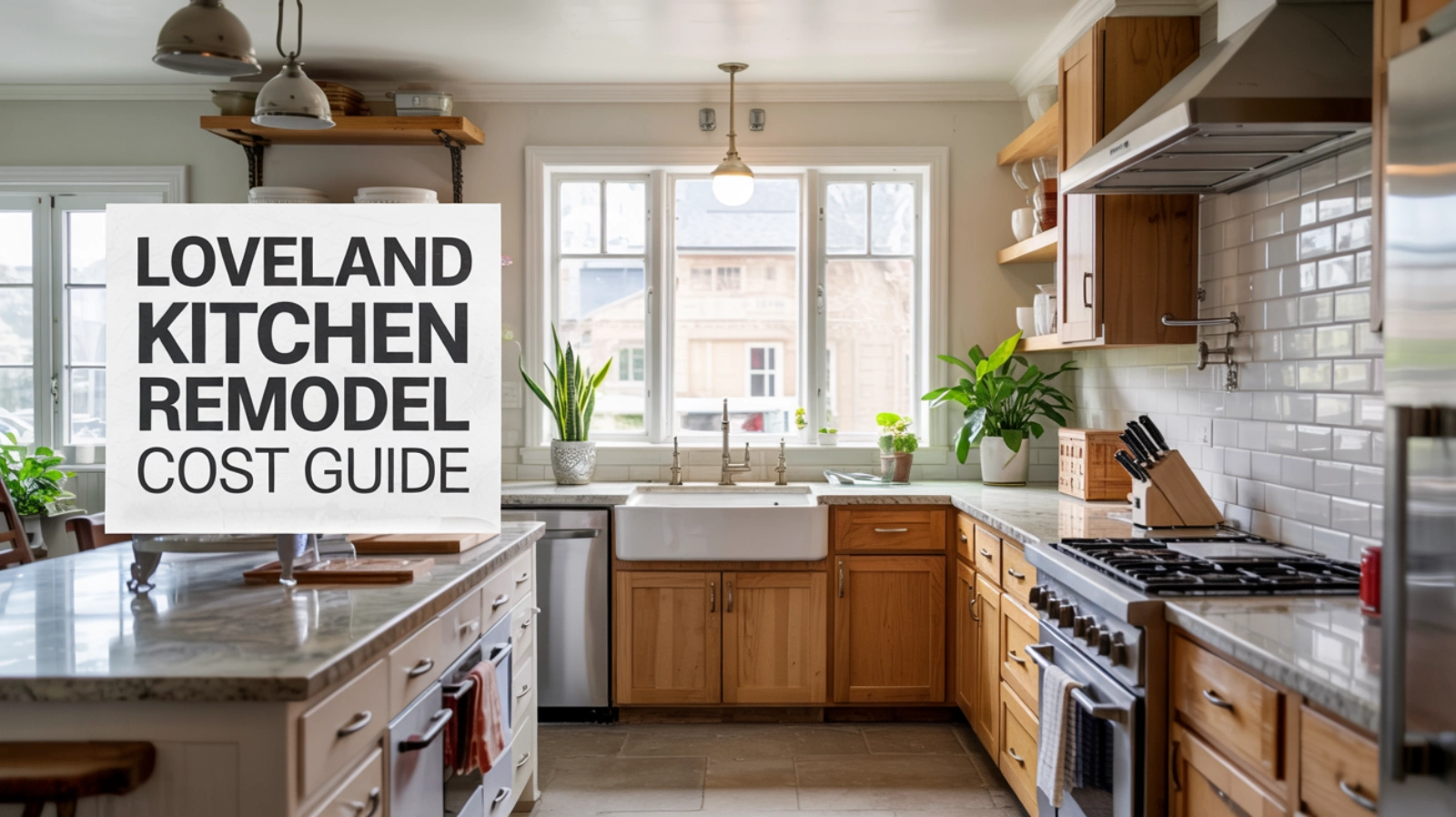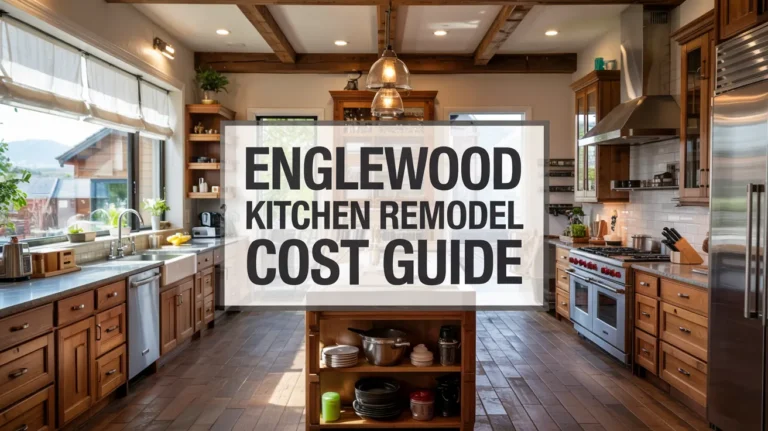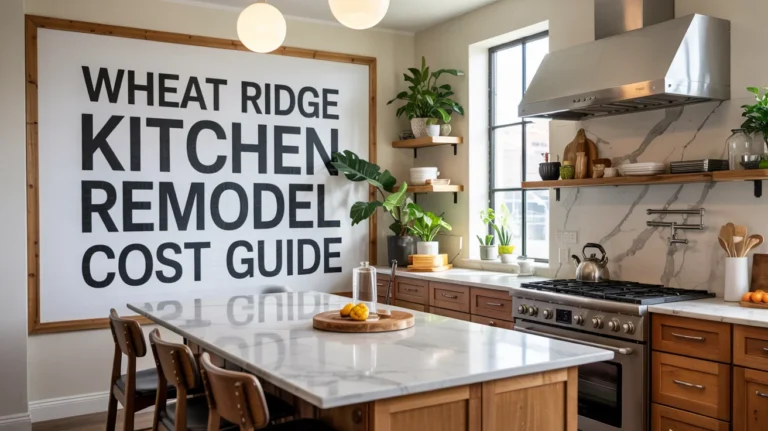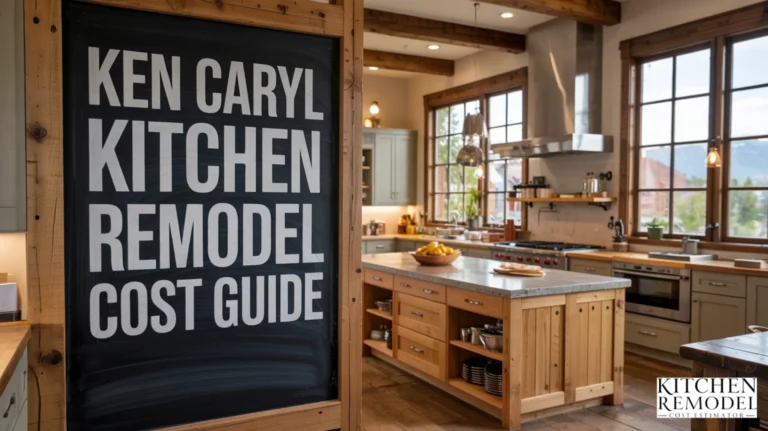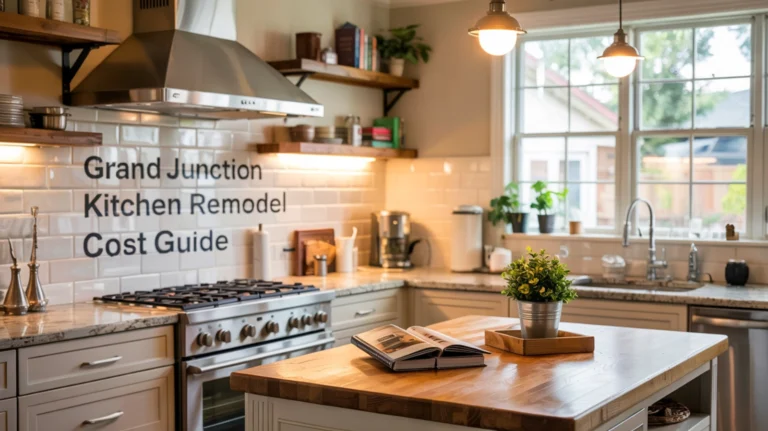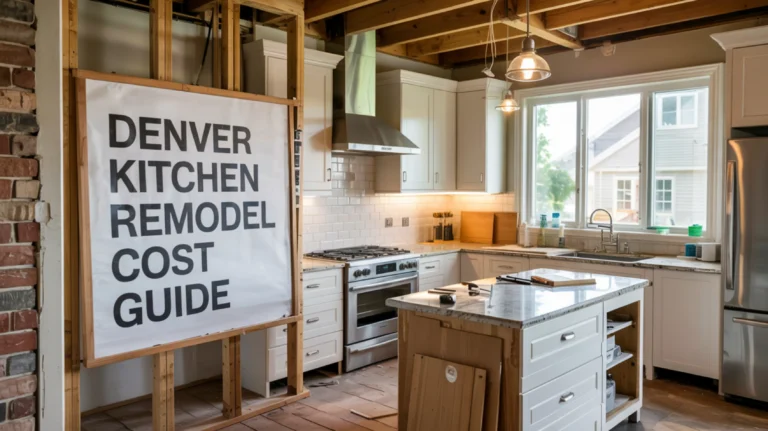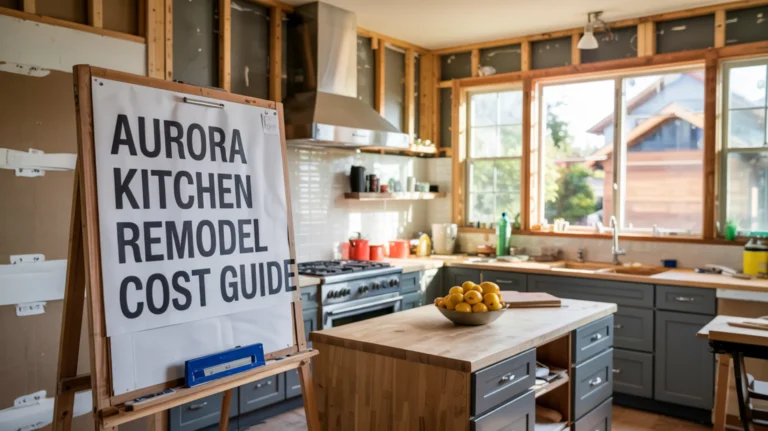Kitchen remodels in Loveland follow their own set of rules. Between our unique mix of historic Craftsman properties and newer developments, what works along the Front Range doesn’t always translate to a successful renovation here. You’ll navigate everything from cabinetry that needs to withstand our dramatic humidity swings to permit processes that differ dramatically between city limits and unincorporated Larimer County properties.
So what’s the magic number for transforming your Loveland kitchen in 2025?
The average kitchen remodel cost in Loveland, Colorado ranges from $15,000 to $40,000 depending on size, materials, and labor. Minor remodels can start around $10,000, while high-end renovations with custom cabinets and stone countertops may exceed $50,000.
Kitchen Remodel Cost Estimator for Loveland
Loveland Kitchen Remodel Cost Calculator
Get an estimate for your kitchen renovation based on your specifications.
Estimated Kitchen Remodel Cost
This estimate is based on national averages and may vary based on your location, material availability, contractor rates, and other factors. Prices are estimates only and should be used for planning purposes.
Looking for more accurate costs in your area? Search for location-specific remodel costs.
Cost Breakdown by Category
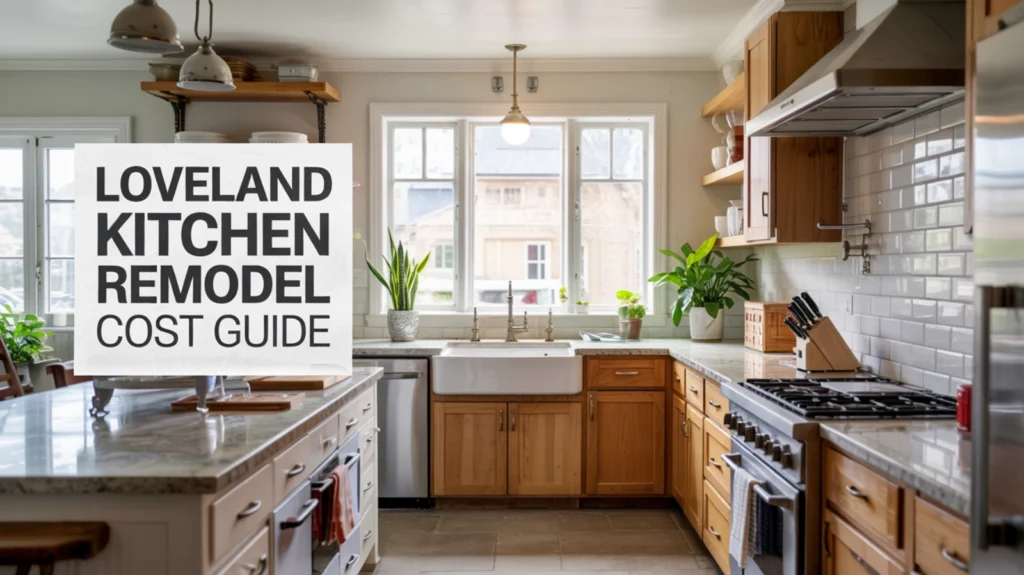
Ever wonder where your kitchen remodel dollars actually go? If you’re planning to renovate in Loveland, Colorado, understanding these typical allocations will help you create a realistic financial roadmap.
Let’s cut to the chase: materials will consume the lion’s share of your budget. But exactly how does that break down?
Cabinets will likely be your biggest single expense, gobbling up around 29% of your total budget. That percentage swings dramatically based on your choices though.
Are you looking at stock cabinets from a big box store, semi-custom options with some personalization, or fully custom cabinetry built specifically for your space? The materials matter too—solid wood commands premium prices compared to plywood, particleboard, or MDF alternatives.
For minor remodels, you might consider refacing or painting existing cabinet boxes to manage costs. Maybe just replace the fronts and hardware while keeping the boxes intact? Major remodels typically involve a complete cabinet overhaul, possibly adding an island or custom built-ins that transform how your kitchen functions.
Countertops typically account for about 10% of your budget. Here’s where material selection makes a huge difference.
Are you comfortable with laminate for a basic update? Or are you dreaming of granite or quartz that prevails in mid-range projects? Perhaps you’re eyeing natural stone, engineered materials, or solid surfaces that define upscale kitchens? Stone pricing especially can vary wildly depending on rarity and grade.
Appliances & Ventilation will consume roughly 14% of your budget. How extensive are your appliance plans?
A basic remodel might involve replacing just your essential workhorses—the range and refrigerator—often with energy-efficient models. More ambitious projects typically include a full suite of new appliances, potentially incorporating built-in units, commercial-grade equipment, or specialized ventilation systems that dramatically improve your cooking experience.
Flooring constitutes about 5% to 7% of most budgets. This choice affects both aesthetics and your daily comfort.
Common options include resilient flooring like vinyl or linoleum, ceramic or porcelain tile, or natural hardwood and wood-look alternatives. Each brings different durability, maintenance, and comfort considerations to your kitchen.
Fixtures like sinks and faucets, combined with associated plumbing work, represent around 4% of typical budgets. This seemingly small category can actually transform how you use your kitchen.
Sink options range from standard double-tub stainless steel models to undermount sinks that streamline countertop cleaning. Faucets, meanwhile, span from basic single-lever designs to statement pieces with features like touchless operation or integrated water filtration.
Lighting takes approximately 5% of your budget but might deliver the biggest impact per dollar spent. This includes ambient illumination, task lighting over work areas, and accent lighting like undercabinet fixtures that make prep work easier and safer.
Backsplash materials claim about 5% of typical budgets. This wall-protecting design element provides major visual impact in ceramic tile, glass tile, stone, or other creative materials.
Other Materials round out your materials budget—paint, trim, wall coverings, new doors or windows (around 4%), and cabinet hardware like pulls and handles. These small details often create the finished look that ties everything together.
Now, what about labor costs? This is where budgets get tricky.
Regional data shows labor’s share of Loveland kitchen remodels ranges incredibly widely—from 17% to as much as 50% of total project cost. Why such variation?
It depends largely on what’s included in that “labor” line item. Lower percentages typically reflect just the direct costs of tradespeople (plumbers, electricians, installers), while higher percentages often include general contractor fees, project management, design work, and the operational overhead of larger firms.
Project complexity dramatically influences labor costs too. Are you moving walls? Relocating plumbing? Altering electrical systems? Each complexity factor drives that percentage higher.
For an accurate labor budget in Loveland, skip the averages. Instead, get detailed, project-specific quotations from multiple contractors. Make sure they clarify exactly what services are included in their “labor costs” line item.
Design fees aren’t always broken out separately in estimates, but they’re definitely part of the equation—especially for mid-range to upscale remodels involving significant layout changes or custom features. These might be bundled into a design-build firm’s overall pricing or charged separately by an independent designer.
Don’t forget permit fees! The City of Loveland calculates these based on your project’s total declared value.
As your materials and labor choices get more expensive, your permit fees increase proportionally. While it might be tempting to under-declare project value, this carries legal risks you shouldn’t take. Budget for accurate permit costs based on your actual project value.
Cost Benchmarks and ROI
“How much per square foot?” It’s often the first question homeowners ask when contemplating a kitchen remodel. But is this really the most useful metric?
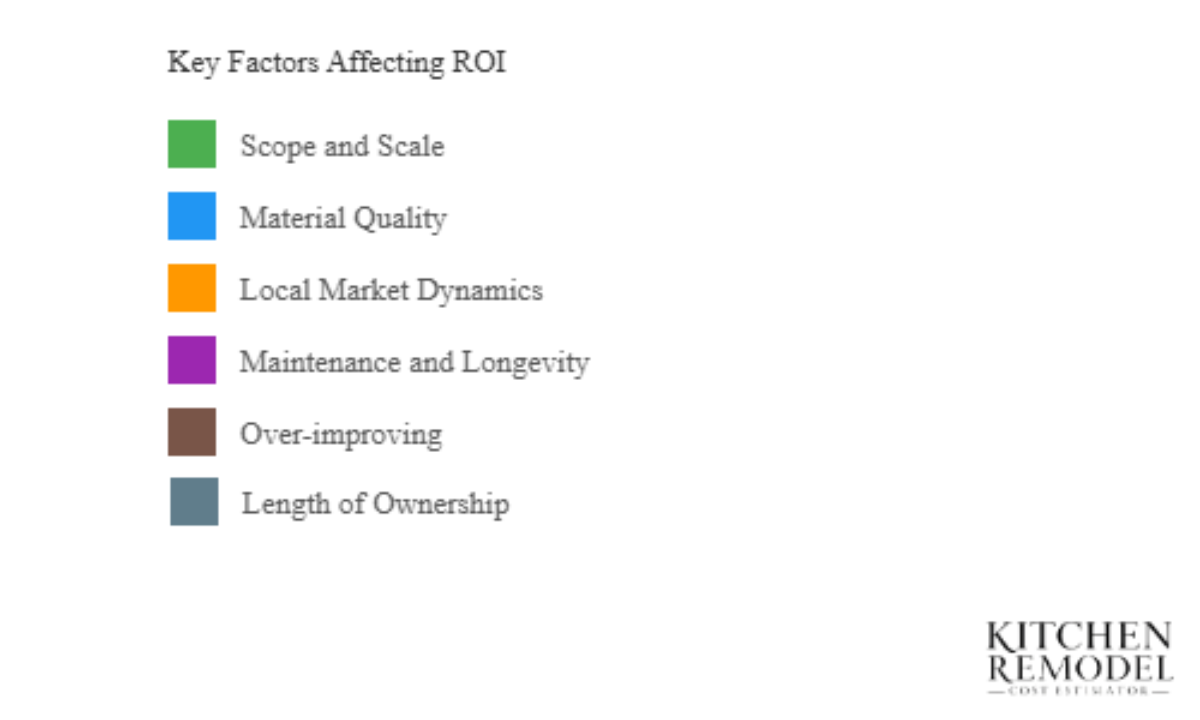
Let’s look at what the numbers tell us for Loveland, using nearby Denver as our data proxy.
Denver kitchen remodels range dramatically—from $75 to $375+ per square foot. That’s an enormous span! What explains this five-fold difference in pricing?
The answer isn’t primarily geographic. It’s about scope and quality. The lower end ($75-$190) typically reflects basic cosmetic refreshes, while the upper range ($250-$375+) represents substantial renovations with premium materials.
Your specific choices matter far more than regional averages. Are you painting cabinets or replacing them? Installing laminate counters or quartz? Keeping your layout or reconfiguring everything?
Estimated Cost Per Square Foot Ranges (Loveland Proxy – Based on Denver Data)
| Remodel Scope | Estimated Cost per Sq. Ft. Range | Data Sources |
|---|---|---|
| Minor/Basic | $75 – $150 | 1 |
| Mid-Range | $150 – $275 | 1 |
| Upscale/Luxury | $275 – $375+ | 1 |
Looking at total project costs gives us a clearer picture of what you might actually spend. These benchmarks typically fall into three categories:
Minor/Basic Remodel: This focuses mainly on surface improvements—refacing or painting existing cabinets, swapping laminate countertops, installing a new sink and faucet, replacing key appliances, and refreshing the flooring.
Denver contractor estimates for these projects often range from $7,000-$10,000. However, here’s something interesting: the standardized 2024 Cost vs. Value report cites a much higher figure—$27,492—for what it defines as a “Minor Midrange Kitchen Remodel” in the Denver market.
Why the big difference? The Cost vs. Value definition likely includes more comprehensive work than what some contractors classify as “minor.”
Mid-Range Remodel: Now we’re replacing most kitchen components—cabinets (typically semi-custom wood), countertops (often granite or quartz), all appliances (energy-efficient models), new flooring, and possibly adding an island or making minor layout adjustments.
For this level, Denver estimates range widely from $11,000-$25,000 for smaller kitchens to $19,000-$75,000 for medium spaces (100-200 sq ft). Again, the 2024 Cost vs. Value report shows a higher benchmark—$79,982—for its standardized “Major Midrange Kitchen Remodel.”
Upscale/Luxury Remodel: Here we’re talking complete transformation—often starting with a full gut. You’ll get layout reconfiguration, high-end custom cabinetry, premium stone countertops, commercial-grade appliances, sophisticated lighting, and top-tier flooring.
Denver estimates for this level start around $26,000-$50,000+ for a “full renovation” and climb to $38,000-$150,000+ for truly high-end transformations. Large kitchens (200+ sq ft) typically start at $55,000 and can exceed $112,500. The 2024 Cost vs. Value “Major Upscale Kitchen Remodel” benchmark hits $158,530.
Have you noticed the pattern? Cost vs. Value figures consistently run higher than some local contractor estimates. Why?
The standardized Cost vs. Value report uses detailed, specific project definitions and pulls data from systematic surveys. Local contractor estimates might reflect less comprehensive scopes or different quality assumptions. For conservative budgeting—especially when assessing potential return on investment—the higher Cost vs. Value figures provide more reliable benchmarks.
Estimated Total Cost Ranges by Scope (Loveland Proxy – Based on Denver/CvV Data)
| Remodel Scope (Cost vs. Value Definition) | Typical Kitchen Size Assumed | Estimated Cost Range | Data Sources |
|---|---|---|---|
| Minor Midrange Kitchen Remodel | 200 sq ft | ~$27,492 | 17 |
| Major Midrange Kitchen Remodel | 200 sq ft | ~$79,982 | 18 |
| Major Upscale Kitchen Remodel | 200 sq ft | ~$158,530 | 18 |
But here’s the question that really matters: How much of your investment will you recoup when selling your home?
This is where Return on Investment (ROI) becomes crucial. It measures the monetary value your remodel adds to your home’s sale price compared to what you spent.
The results might surprise you.
Minor Kitchen Remodel: This consistently shows the highest ROI. Denver-specific data suggests remarkable returns—96.1% or even 97.4%. That means you’re recovering almost everything you spent! The national average is similarly impressive at 96.1%. Some regions fare even better, with the Pacific region hitting 134.3% (yes, actually making money on the investment).
Mid-Range Major Kitchen Remodel: ROI drops significantly here. Denver data shows returns around 49.5% to 74.8%, with other local sources citing 72% or 62%.
Upscale Major Kitchen Remodel: Despite all those gorgeous high-end features, this yields the lowest percentage return—just 38% in Denver, matching the national average.
Here’s something even more interesting: The highest-returning home improvements often aren’t kitchens at all. In the Mountain Region, replacing a steel entry door yields an estimated 185.2% ROI, a new garage door returns 174.4%, and adding manufactured stone veneer brings 124.3%.
What does this tell us? Minor kitchen remodels focusing on high-impact cosmetic updates deliver disproportionately high financial returns compared to extensive, high-cost overhauls.
For maximizing resale value, targeted minor kitchen updates represent the most financially efficient strategy. Major renovations with structural changes or luxury finishes certainly enhance your lifestyle and enjoyment, but they typically yield lower financial returns percentage-wise.
What factors influence the actual ROI you’ll achieve?
Scope and Scale: Smaller updates generally yield higher percentage returns than major renovations.
Material Quality: There’s a sweet spot here. Mid-range materials often provide the best balance between cost and resale value. That super-expensive imported marble might not bring proportional returns in a standard neighborhood.
Local Market Dynamics: High-demand markets like Denver/Loveland place premium value on updated kitchens, boosting your potential ROI.
Maintenance and Longevity: Durable, low-maintenance materials appeal strongly to buyers. No one wants to replace expensive features soon after purchase.
Another consideration: How long will you stay in your home after remodeling? Longer durations allow market appreciation to potentially offset your initial investment, improving your effective return.
Estimated ROI Percentages (Loveland Proxy – Based on Denver/CvV Data)
| Remodel Scope (Cost vs. Value Definition) | Average Cost | Average Resale Value Added | Estimated ROI % | Data Sources |
|---|---|---|---|---|
| Minor Midrange Kitchen Remodel | ~$27,492 | ~$26,406 | ~96.1% | 17 |
| Major Midrange Kitchen Remodel | ~$79,982 | ~$39,587 | ~49.5% | 18 |
| Major Upscale Kitchen Remodel | ~$158,530 | ~$60,176 | ~38.0% | 18 |
| Comparison: Steel Entry Door (Mountain) | ~$2,355 | ~$4,361 | ~185.2% | 20 |
| Comparison: Garage Door (Mountain) | ~$4,513 | ~$7,870 | ~174.4% | 20 |
Does this mean you shouldn’t do that dream kitchen renovation? Not at all!
If you’ll enjoy your spectacular new kitchen for many years, the lower ROI percentage might be completely justified by your improved quality of life. Just go in with eyes wide open about the financial returns you can reasonably expect.
Loveland Permitting and Building Codes
Thinking about skipping permits for your kitchen remodel? You might want to reconsider that strategy.
Permits aren’t just bureaucratic hoops—they protect your investment by ensuring work meets safety standards and can prevent expensive headaches when you eventually sell your home. Let’s break down what you need to know in Loveland.
City of Loveland Requirements
If your property sits within Loveland city limits, you’ll be working with the City’s Building Division.
What exactly requires a permit? Generally, you’ll need one for constructing, enlarging, altering, repairing, moving, demolishing, or changing the occupancy of your home. This explicitly includes installing, altering, or replacing electrical, gas, mechanical, or plumbing systems.
The City specifically lists “Interior Remodel” as a residential project requiring permits when it involves structural modifications or changes to electrical, plumbing, or mechanical systems.
But there’s good news for minor updates. Purely cosmetic work—like painting, non-structural cabinet replacement, countertop swaps (without plumbing changes), tiling, or installing new flooring—may be exempt if you’re not touching regulated systems or making structural changes.
Is your home on the Loveland Historic Register? There’s an extra step. You’ll need a separate Landmark Alteration Approval before any exterior modifications, though interior remodeling is generally exempt unless you’re changing doors or windows.
As of June 2023, Loveland follows the 2021 editions of International Code Council (ICC) standards, including the International Residential Code, Building Code, Mechanical Code, Plumbing Code, and others. The city also adopted the 2023 National Electrical Code.
Why does this matter? These newer codes might be stricter than what was in place when your home was built. Your remodel could trigger requirements to update electrical, plumbing, or energy systems to current standards—potentially adding unforeseen costs for things like additional GFCI outlets, arc-fault protection, or enhanced insulation if you’re opening up walls.
The permitting process in Loveland follows several steps:
Application: Submit required forms and digital drawings via email to [email protected]. There’s a specific “ALTERATION” application packet available.
Review: Multiple departments will examine your plans, including the Loveland Fire Rescue Authority for safety compliance. Plan on 20-30 working days for each review round. Depending on your project scope, you might need drawings stamped by a Colorado-licensed design professional.
Issuance: Once approved and fees paid, you’ll receive your building permit. Fees are based on your project’s declared value. You must post the permit card visibly at your project site throughout construction.
Inspections: These verify code compliance at various stages. Schedule them through the CitizenAccess portal or by calling 970-962-2100. Keep a printed color copy of your approved plans on-site for the inspector. Fire safety inspections require separate scheduling directly with LFRA.
Completion: Your remodeled kitchen can’t be used until it passes final inspection. Permits typically expire if work doesn’t start within 180 days or if it’s suspended for 180 days. Unless extended, permits generally void after 12 months.
Who can actually perform the work? As a homeowner, you can obtain permits and work on your own primary residence (single-family detached homes) by submitting a Homeowner Affidavit. But for rental properties, multi-family buildings, or non-residential structures, you’ll need a contractor with a valid City of Loveland Contractor’s License. Verify a contractor’s license status by contacting the Building Division.
Contact Information (City of Loveland):
- Building Division: 410 E 5th St, Loveland, CO 80537
- General Inquiries / Licensing: 970-962-2505
- General Permit Info: 970-962-2346
- Inspection Scheduling: 970-962-2100
- Inspection Time Info (Day Of): 970-962-2181
- Residential E-plan Submittal: [email protected]
- Loveland Fire Rescue Authority (LFRA): 410 E 5th St, Loveland, CO 80537
- Fire Inspections Scheduling: 970-962-2537
Larimer County Requirements (Unincorporated Areas)
Does your home sit outside city limits? The rules change a bit.
For properties in unincorporated Larimer County, you’ll work with the Larimer County Building Department instead of the city.
The county requires permits for most construction activities—including kitchen expansions—and starting work without required permits will result in a Stop Work Order and potentially doubled fees. Not worth the risk!
Larimer County enforces the 2021 ICC codes for permits started after March 1, 2022, and the 2023 National Electrical Code as of August 1, 2023. Depending on your property’s location, you might face additional requirements like wildfire mitigation inspections.
Here’s where things get tricky—the county permitting process differs from the city’s:
Application: You’ll need a valid parcel number. Forms are available online or at the county office. For unincorporated areas, you must submit digital drawings separately to LFRA for fire code review using their specific application.
Review: The County Building Department reviews for building, electrical, plumbing, and mechanical compliance, while LFRA conducts a separate review for fire safety. This creates a two-track system.
Issuance: You’ll receive separate permits—one from the County Building Department and another from LFRA. Both permit cards and approved plans must remain on-site.
Inspections: Request county inspections via phone (970-498-7697) or their online portal. Fire system inspections are coordinated separately with LFRA.
Completion: You’ll need final approval from all agencies before receiving a Letter of Completion or Certificate of Occupancy.
As property owner, you bear ultimate responsibility for obtaining all required permits before work begins, regardless of whether you hire a contractor.
The need to coordinate with two distinct entities—Larimer County and the Loveland Fire Rescue Authority—creates an administrative complexity that city residents don’t face. This dual-track system requires careful management of applications, fees, and inspection scheduling with both organizations.
Contact Information (Larimer County – Unincorporated):
- Larimer County Building Department: 200 W Oak St, Suite 3100, Fort Collins, CO 80522
- General Inquiries: 970-498-7700
- Inspection Request Line: 970-498-7697
- Email: [email protected]
- LFRA (for County projects): See City of Loveland contact info; requires separate submittal process via [email protected] or other methods.
Material and Construction Standards
%%{init: {'theme': 'neutral'}}%%
graph TD
A[Material Standards] --> B(Cabinets);
A --> C(Countertops);
A --> D(Flooring);
B --> B1[KCMA A161.1];
B1 --> B1a(Quality/Durability);
B --> B2[KCMA ESP];
B2 --> B2a(Env. Impact);
B --> B3[ASTM Standards];
B3 --> B3a(Materials/Testing);
C --> C1[ANSI/AWI 1236];
C1 --> C1a(Fabrication/Performance);
C --> C2[NSF/ANSI 51];
C2 --> C2a(Food Safety);
C --> C3[ADA/ANSI A117.1];
C3 --> C3a(Accessibility);
C --> C4[Other Standards];
C4 --> C4a(Tile, Greenguard, Kosher);
D --> D1[ASTM Standards];
D1 --> D1a(Installation/Testing);
D --> D2[ASTM F710];
D2 --> D2a(Concrete Prep);
D --> D3[Resilient Flooring];
D3 --> D3a(ASTM Specs/Tests);
D --> D4[Wood Flooring];
D4 --> D4a(ASTM Tests);
D --> D5[Ceramic Tile];
D5 --> D5a(ANSI/TCNA);
D5 --> D5b(ANSI A137.1);
D5 --> D5c(ANSI A108/A118/A136);
style A fill:#f9f,stroke:#333,stroke-width:2px;
style B fill:#e6e6ff,stroke:#333,stroke-width:1.5px;
style B1 fill:#FFFFE0,stroke:#333,stroke-width:1.5px;
style B2 fill:#FFFFE0,stroke:#333,stroke-width:1.5px;
style B3 fill:#FFFFE0,stroke:#333,stroke-width:1.5px;
style B1a fill:#fff0f0,stroke:#333,stroke-width:1px;
style B2a fill:#fff0f0,stroke:#333,stroke-width:1px;
style B3a fill:#fff0f0,stroke:#333,stroke-width:1px;
style C fill:#d4e1f5,stroke:#333,stroke-width:1.5px;
style C1 fill:#FFFFE0,stroke:#333,stroke-width:1.5px;
style C2 fill:#FFFFE0,stroke:#333,stroke-width:1.5px;
style C3 fill:#FFFFE0,stroke:#333,stroke-width:1.5px;
style C4 fill:#FFFFE0,stroke:#333,stroke-width:1.5px;
style C1a fill:#fff0f0,stroke:#333,stroke-width:1px;
style C2a fill:#fff0f0,stroke:#333,stroke-width:1px;
style C3a fill:#fff0f0,stroke:#333,stroke-width:1px;
style C4a fill:#fff0f0,stroke:#333,stroke-width:1px;
style D fill:#c2d9e9,stroke:#333,stroke-width:1.5px;
style D1 fill:#FFFFE0,stroke:#333,stroke-width:1.5px;
style D2 fill:#FFFFE0,stroke:#333,stroke-width:1.5px;
style D3 fill:#FFFFE0,stroke:#333,stroke-width:1.5px;
style D4 fill:#FFFFE0,stroke:#333,stroke-width:1.5px;
style D5 fill:#FFFFE0,stroke:#333,stroke-width:1.5px;
style D1a fill:#fff0f0,stroke:#333,stroke-width:1px;
style D2a fill:#fff0f0,stroke:#333,stroke-width:1px;
style D3a fill:#fff0f0,stroke:#333,stroke-width:1px;
style D4a fill:#fff0f0,stroke:#333,stroke-width:1px;
style D5a fill:#fff0f0,stroke:#333,stroke-width:1px;
style D5b fill:#fff0f0,stroke:#333,stroke-width:1px;
style D5c fill:#fff0f0,stroke:#333,stroke-width:1px;Ever wondered how to tell if your new cabinets will survive daily family life? Or whether your countertops are actually food-safe?
Industry standards give us benchmarks for quality, durability, safety, and performance across kitchen materials. They’re developed by organizations like ASTM International, the American National Standards Institute (ANSI), the Kitchen Cabinet Manufacturers Association (KCMA), and NSF International.
Let’s decode what these standards actually mean for your kitchen remodel.
Cabinets
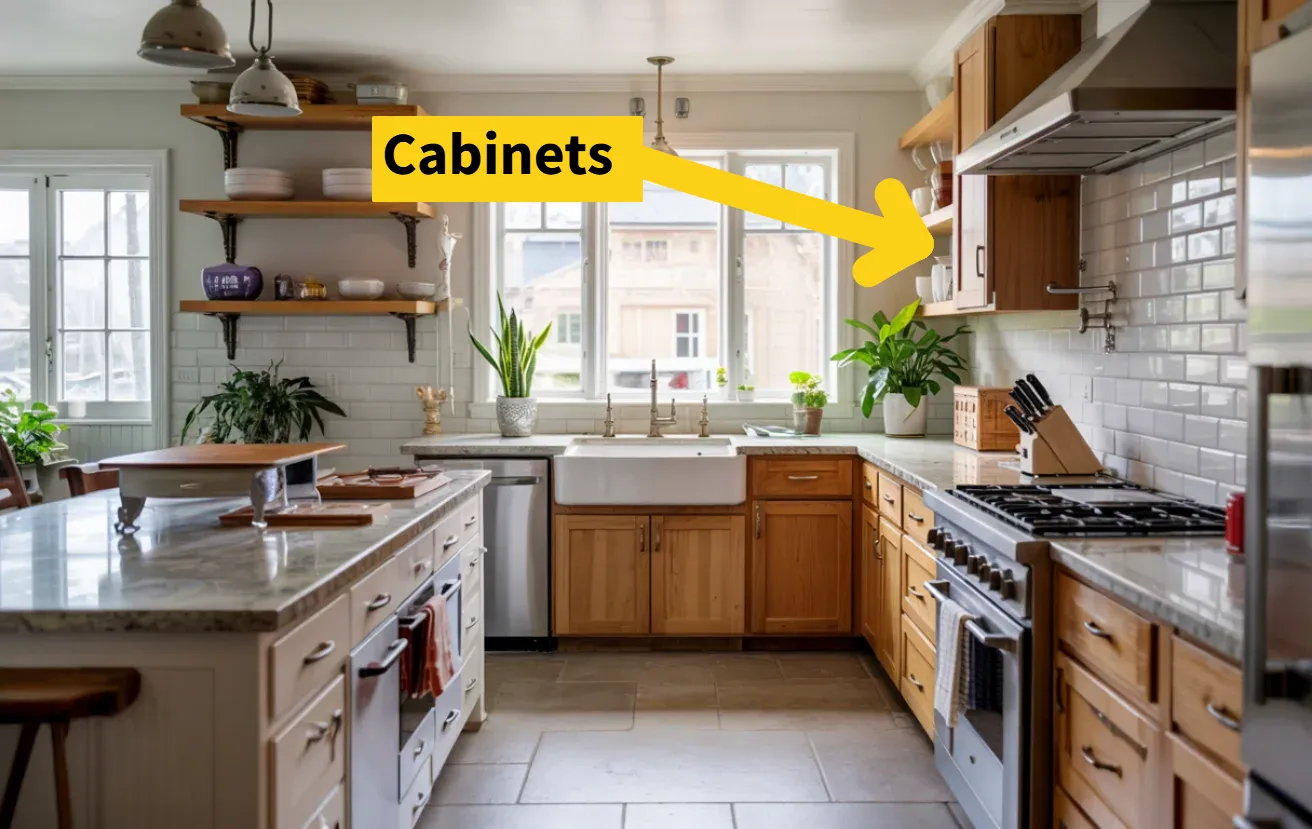
KCMA A161.1 serves as the gold standard for kitchen cabinet quality. This certification requires cabinets to pass rigorous third-party laboratory tests simulating years of typical use.
What are they actually testing? More than you might imagine:
Structural Integrity: Can your wall cabinets hold up to 600 pounds without failing? They should if they’re KCMA certified. Base cabinets undergo similar load testing.
Drawer Durability: Imagine opening and closing your silverware drawer 25,000 times with 15 pounds per square foot loaded inside. That’s roughly 20 years of normal use, and KCMA-certified drawers must handle it without breaking down.
Door Operation: Cabinet doors get loaded with 65 pounds and cycled open and closed multiple times. Any looseness or damage is a failing grade.
Finish Durability: This might be the most interesting test. Cabinet finishes are exposed to everything from extreme temperatures (-5°F to 120°F) to high humidity and 24-hour contact with kitchen substances like vinegar, lemon juice, coffee, ketchup, mustard, olive oil, alcohol, and detergents.
The finish must resist staining, discoloration, blistering, cracking, or other failures. Basically, it has to survive your kitchen’s worst day.
Specifying cabinets with the KCMA Certified seal gives you assured quality without having to become a materials engineer yourself.
KCMA Environmental Stewardship Program (ESP) focuses on cabinet manufacturing’s environmental impact. It verifies responsible practices in sustainable wood sourcing, waste reduction, air quality (low-emission finishes), environmental policies, and community relations.
Choosing ESP-certified cabinets supports manufacturers committed to reducing their environmental footprint.
ASTM Standards cover specific materials or properties used in cabinetry, such as steel, aluminum, fasteners, and specialized performance testing.
Countertops

ANSI/AWI 1236-2022 – Countertops provides comprehensive requirements for various countertop materials, including laminate, solid surface, epoxy resin, natural and engineered stone, wood, and solid phenolic.
What specifically does it address?
Structural Performance: Countertops must support specified loads (50 lbs per 144 square inches) without excessive deflection or permanent damage. Unsupported spans need to handle a 200 lb point load near the front edge.
Joints and Cutouts: All joints between sections must be tight and flush. Sink cutouts face placement restrictions—typically not allowed within 18 inches of a joint—and areas subject to moisture require sealing.
Overhangs: Standard overhangs relative to cabinet faces should be between 0.5 and 1.25 inches, with unsupported overhangs limited to 12 inches maximum.
Material-Specific Requirements: The standard specifies things like requiring moisture-resistant substrates for laminate or wood countertops near sinks, proper adhesive types, and limits for surface imperfections.
NSF/ANSI 51 – Food Equipment Materials addresses the food safety aspect of countertops. This is crucial since you’re preparing food directly on these surfaces.
To achieve certification, materials must be non-toxic (won’t leach harmful substances into food), nonabsorbent (won’t harbor bacteria), smooth, easily cleanable, corrosion-resistant, and durable.
The standard designates different “zones” for materials:
- Food Zone materials are certified safe for direct food contact
- Splash Zone materials are acceptable for areas subject to spills but not direct food contact
- Nonfood Zone materials are for non-contact areas
Always verify a material’s certification zone if food preparation is a primary concern.
Accessibility Standards (ADA/ANSI A117.1) provide requirements for accessible kitchens. Work surfaces should generally be between 28 and 34 inches above the floor, with specific requirements for clear floor space and knee/toe clearance beneath counters.
Other Standards and Certifications include ANSI installation standards for tile countertops, Greenguard certification for low chemical emissions (VOCs), and even Kosher certification for surfaces used in kosher food preparation.
When selecting countertop materials, you’re balancing multiple factors addressed by different standards:
- ANSI/AWI 1236 focuses on construction quality and physical durability
- NSF/ANSI 51 addresses food safety and hygiene
- ADA/ANSI A117.1 covers accessibility
- Greenguard relates to indoor air quality
Your specific priorities will determine which standards matter most for your project.
Flooring
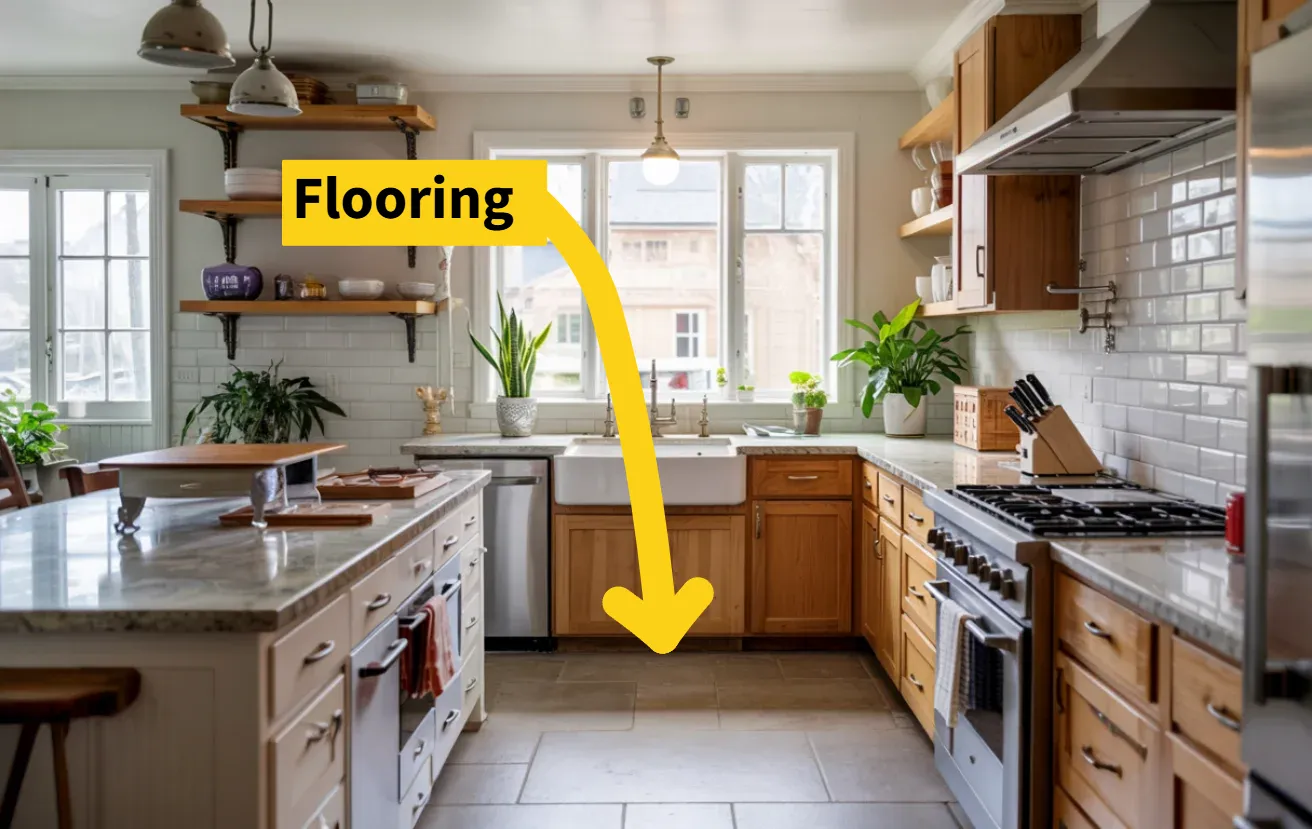
ASTM Standards cover various flooring types, including resilient (vinyl, linoleum, rubber), wood, and concrete substrates. These standards address installation practices, material specifications, and performance testing.
Concrete Slab Preparation (ASTM F710) may not sound exciting, but it’s critical for successful flooring installation. This standard outlines requirements for preparing concrete before installing flooring:
Condition: The concrete must be dry, clean, smooth, and structurally sound, free from contaminants like dust, grease, curing compounds, or excessive alkalinity.
Moisture Testing: This is a big one. Quantitative moisture testing is essential before installing flooring to ensure the concrete’s moisture level won’t damage your new floor. Many warranties are void without proper moisture testing.
Surface Smoothness and Flatness: Cracks, grooves, and depressions must be filled and smoothed using suitable compounds. The standard specifies flatness tolerances—the surface shouldn’t deviate more than 3/16 inch over a 10-foot span, nor more than 1/32 inch over a 1-foot span.
Acclimation: Flooring materials, adhesives, and the installation environment should maintain stable temperature (65°F to 85°F) and humidity (35% to 55%) for at least 48 hours before, during, and after installation.
Inadequate concrete preparation—particularly moisture content and surface flatness—frequently causes flooring failures, leading to adhesive degradation, bubbling, or visible imperfections. These steps represent a critical phase you shouldn’t overlook in your project planning.
Resilient Flooring Standards (ASTM) provide specifications for various resilient flooring products and test methods for evaluating their properties:
Specifications exist for Sheet Vinyl (F1303), Vinyl Composition Tile (F1066), Linoleum Tile (F2195), Rubber Sheet (F1860), and Solid Vinyl Tile/Plank (F1700).
Test Methods evaluate durability through abrasion resistance, impact resistance, puncture resistance, and recovery from static loads. They also assess stability against heat and light and measure physical dimensions.
Wood Flooring Standards (ASTM) address performance under simulated service conditions and material properties:
ASTM D2394 tests wood flooring for concentrated loading, indentation resistance, rolling load durability, abrasion resistance, and coefficient of friction.
Other tests measure density, moisture content, finish properties like adhesion, and general wood properties like strength.
Ceramic Tile Flooring (ANSI/TCNA) standards define tile types, properties, and installation methods:
ANSI A137.1 classifies ceramic tiles based on water absorption (porcelain tile has ≤ 0.5% absorption) and specifies requirements for physical properties like breaking strength and dimensional tolerances. It also sets standards for measuring slip resistance, with a minimum threshold for wet areas.
ANSI A108/A118/A136 detail installation methods and materials, including mortars, grouts, and adhesives.
TCNA Handbook provides practical installation guidance with diagrams for various methods.
Ceramic tile offers inherent benefits like durability, fire and chemical resistance, easy cleaning, and hypoallergenic properties. Numerous slip-resistant options exist for kitchen applications.
Understanding these standards helps you select appropriate materials and installation methods for your kitchen remodel, ensuring long-term performance and satisfaction.
Local Market Factors: Loveland, Colorado
What makes a Loveland kitchen distinctly “Colorado”? And how do local resources, preferences, and labor costs affect your remodeling decisions?
Understanding these local market nuances helps you create a kitchen that feels at home in Loveland while making smart budget decisions.
Common Design Preferences and Trends
Kitchen designs in Northern Colorado blend popular national trends with local influences, favoring styles that incorporate natural elements and prioritize functionality.
Layouts: Open-concept kitchens that flow into adjacent living areas dominate the local scene. Why? They reflect Colorado’s emphasis on gathering spaces and connection to surroundings.
Kitchen islands have become nearly ubiquitous, serving as multi-functional hubs for prep work, casual dining, homework sessions, and social gatherings. Traditional L-shaped and U-shaped layouts remain practical choices, especially in homes with defined floor plans.
Cabinets: Shaker-style doors lead the popularity contest even in basic remodels. But look beyond door styles and you’ll see several regional trends:
- Glass-front cabinets for displaying mountain pottery or family heirlooms
- Cabinets extending to the ceiling for maximum storage (and to accommodate all that camping gear!)
- Large base drawers instead of doors for easier access
- Soft-close hardware that eliminates slamming
While closed cabinets dominate for practical storage, selective open shelving sometimes appears as an airy design feature. Local custom cabinet makers offer alternatives to big-box options, with some emphasizing Colorado-sourced wood that’s already acclimated to our distinctive climate cycles.
Countertops: Natural stone (particularly granite) and engineered quartz dominate mid-range and upscale projects. There’s also a resurgence of solid hardwood countertops and large-format natural stone slabs that showcase unique mineral patterns—reflecting Colorado’s appreciation for natural materials.
Colors and Finishes: Warm, comforting earth tones reflect the regional landscape, with shades like “Mocha Mousse” (a rich brown) trending for 2025. Stainless steel remains the go-to for appliances, while natural materials—especially wood and stone—prevail throughout, aligning with Colorado’s outdoor-oriented aesthetic.
Backsplashes range from classic subway tiles to intricate mosaics. In historic renovations, you might even spot unique applications like stained hardwood that connects to Loveland’s heritage.
Appliances and Technology: Energy efficiency increasingly drives appliance selection, reflecting Colorado’s environmentally conscious culture. Dual fuel ranges (gas cooktop with electric oven) are prized for cooking performance but may require installing a gas line in homes without one.
Quiet operation and sanitizing features are valued in dishwashers—practical considerations for busy families. Smart home technology integration is emerging in higher-end kitchens, controlling everything from lighting to coffee makers.
Historic Homes: Loveland’s older homes (some exhibiting Craftsman style) present special considerations. Homeowners often seek to blend modern functionality with elements that preserve “authentic old-town feel”—like stained hardwood floors or unique tile work that honors the home’s character.
The prevailing design direction balances functional, modern layouts with a regional preference for warmth and texture from natural materials, typically within transitional, modern farmhouse, or updated craftsman aesthetics. Ultra-modern or highly specific niche styles tend to have narrower appeal than designs incorporating these regional tendencies.
Material Availability and Local Suppliers
A range of suppliers serves the Loveland and Northern Colorado area, each with different specialties.
Specialty Lumber and Wood Products: Suppliers like Cedar Supply (Fort Collins) offer materials typically absent from large home centers—various cedar products, dimensional lumber, shingles, timbers, Douglas fir, hardwood decking, specialty siding, trim, and specialty wood stains.
The benefit of locally sourced wood that’s acclimated to Colorado’s dramatic climate fluctuations shouldn’t be underestimated. It can significantly reduce expansion and contraction issues that plague hastily installed “import” products.
General Building Materials: Larger suppliers like Builders FirstSource (Denver locations) and Rio Grande Co. (Denver, Fort Collins, and mountain locations) provide core construction materials.
Builders FirstSource stocks lumber, plywood, sheathing, roofing, insulation, siding, decking, and manufactured components like trusses. Rio Grande Co. specializes in masonry products, concrete accessories, structural steel, stucco, stone, tile, fireplaces, hardware, and tools.
Cabinetry: Beyond the national brands at big box stores, Loveland homeowners have access to local custom cabinet makers. These artisans often provide more personalized service and design flexibility than mass-market alternatives.
While standard construction materials are generally available without delay, specialized items require planning. Unique hardwoods, custom-milled trim, imported tiles, or non-standard appliance models may involve extended lead times. Your project timeline should factor in these potential delays.
Interestingly, locally sourced and acclimated wood products often perform better long-term in Colorado’s extreme climate cycles. This regional consideration might influence material choices, especially for cabinet and flooring applications.
Labor Market Wage Benchmarks
What should you expect to pay for skilled trades in Loveland? Understanding typical wage rates provides context for the labor portion of your remodel budget.
Remember: The figures below represent average hourly wages paid to employees, not the billing rates charged to you as a customer. Those billing rates include overhead, insurance, profit, and other business costs.
Plumbers: Average hourly wages in Loveland cluster around $29-$31 per hour, with a typical range spanning approximately $23-$36 per hour. Colorado’s state average is similar at about $30.47 per hour. Master Plumbers with years of experience command higher wages—often at the top of this range or beyond. Local job postings frequently advertise rates between $25 and $45 per hour.
Electricians: In Loveland, electricians earn around $30 per hour on average, typically ranging from $25-$34 per hour. However, customer billing rates tell a different story—usually between $32 and $48 per hour, illustrating the significant markup needed to cover business costs. Journeyman electricians earn substantially more than apprentices, and all electrical workers in Colorado must maintain state licensing.
Carpenters: Local carpenters average around $26 per hour, typically ranging from $21-$29 per hour. Colorado’s state average runs slightly higher at $29 per hour. Cabinet installation specifically might be priced differently—sometimes per linear foot (around $70) or per cabinet unit (approximately $100). Job postings in the area generally advertise between $23 and $40 per hour.
Why does this matter to you? Because labor costs represent a major wild card in remodeling budgets.
Skilled trade wages in Loveland generally fall within the $25-$40 per hour range. But what contractors actually charge you will be substantially higher. Those billing rates must cover not just the wage but also:
- Payroll taxes and benefits
- Liability and workers’ compensation insurance
- Vehicle and tool costs
- Office overhead and administrative expenses
- Project management time
- Profit margin
These factors explain the significant difference between reported average wages and your final labor costs. They also help explain why labor percentages in remodeling budgets vary so dramatically (from 17% to 50% of total project cost).
When estimating your kitchen remodel, rely on actual contractor billing rates obtained through detailed quotes—not raw wage data. And make sure those quotes clearly specify exactly what services are included in the stated labor costs.
Estimated Hourly Wage Ranges for Key Trades (Loveland/Colorado)
| Trade | Typical Hourly Wage Range (25th-75th Percentile) | Average Hourly Wage | Data Sources | Note on Billing Rates |
|---|---|---|---|---|
| Plumber | ~$23 – $36 | ~$29 – $31 | 76 | Billing rates charged to clients are significantly higher |
| Electrician | ~$25 – $34 | ~$30 | 79 | Billing rates estimated $32-$48/hr |
| Carpenter | ~$21 – $29 | ~$26 – $29 | 82 | Billing rates charged to clients are significantly higher |
Conclusion
Ready to remodel your Loveland kitchen? Here’s what you need to know about costs, regulations, and local factors.
The price tag varies dramatically based on scope, material quality, labor rates, and regulatory requirements. Minor, cosmetic updates offer the highest ROI—typically recouping over 90% of their cost when you sell. Major high-end renovations provide substantial lifestyle improvements but yield lower financial returns (often below 50%).
Labor costs represent the most variable budget component, with reported percentages ranging from 17% to 50% of total project cost. This swing highlights why detailed, project-specific quotes are essential. Make sure contractors clarify what their “labor” line item actually includes—direct work? management? design services?
Local skilled trades typically earn $25-$40 per hour, but remember: what you’ll pay is substantially higher after markup.
Code compliance isn’t optional. Both Loveland and Larimer County enforce the 2021 International Codes and 2023 National Electrical Code. This might require upgrading systems beyond your immediate cosmetic changes, affecting your budget. The permitting process differs between city limits (integrated review) and unincorporated areas (separate county and fire permits), with the latter adding administrative complexity.
Material selection should consider both aesthetics and performance standards. Look for KCMA A161.1 certification for cabinets, ANSI/AWI 1236 for countertops, and appropriate ASTM standards for flooring. For food preparation surfaces, NSF/ANSI 51 certification ensures safety.
Local design preferences blend modern functionality with natural materials and warmer earth tones, reflecting Colorado’s distinctive aesthetic. While standard materials are readily available, specialty items may require additional lead time.
Don’t overlook proper substrate preparation—particularly for flooring installations over concrete. Following ASTM F710 standards for moisture testing and surface flatness can prevent costly failures down the road.
By understanding these Loveland-specific factors and planning accordingly, you’ll be well-positioned to create a kitchen that enhances both your daily life and your home’s value for years to come.

